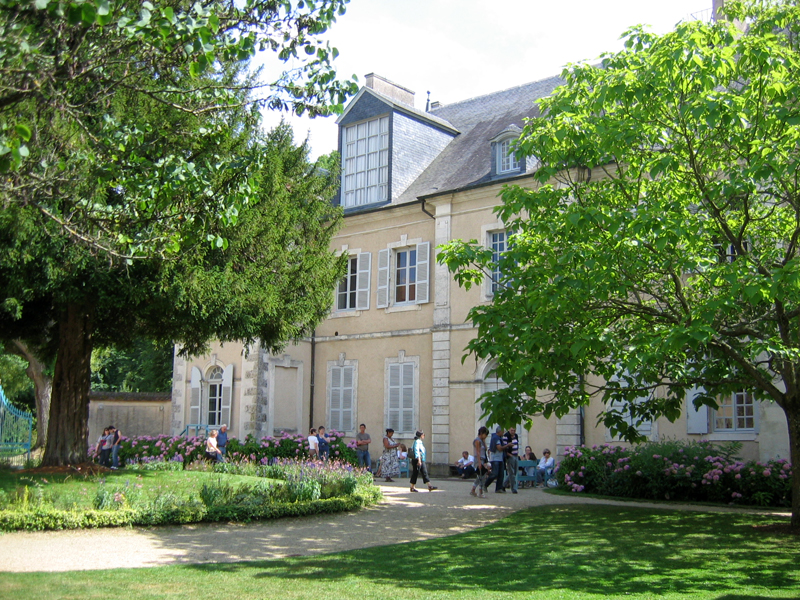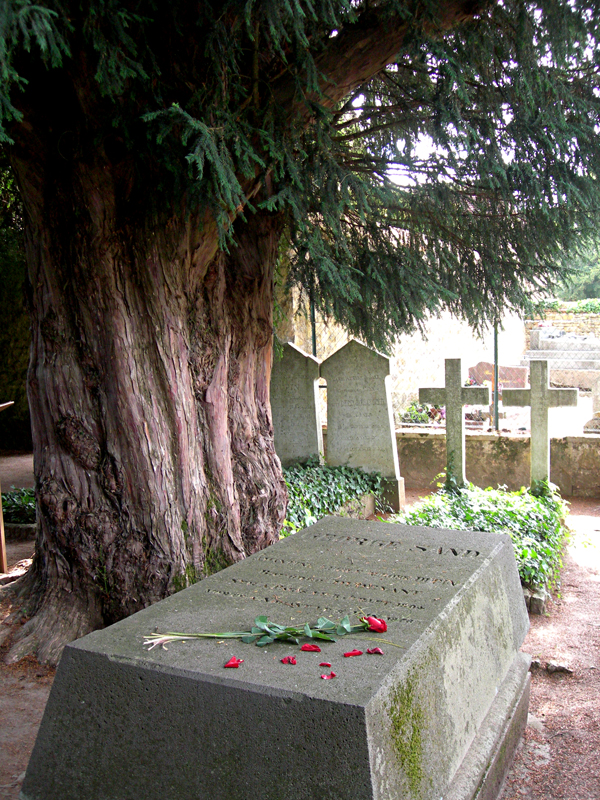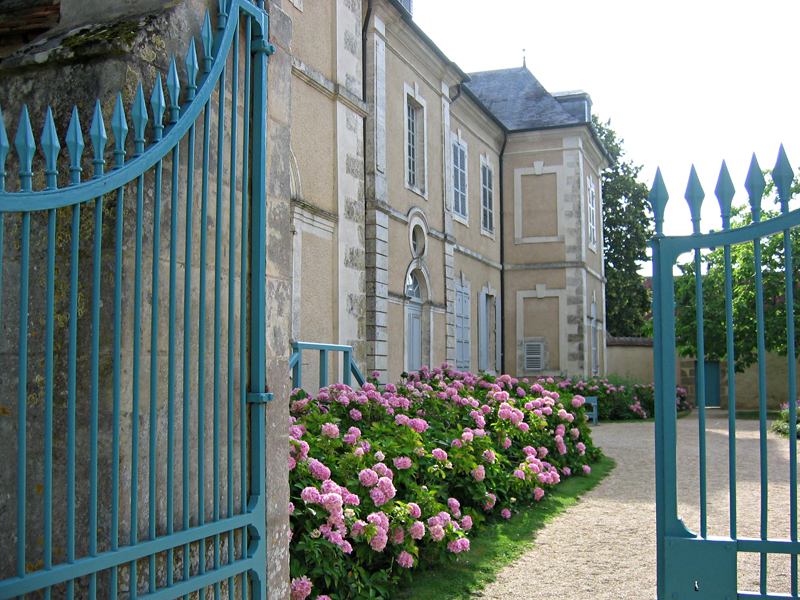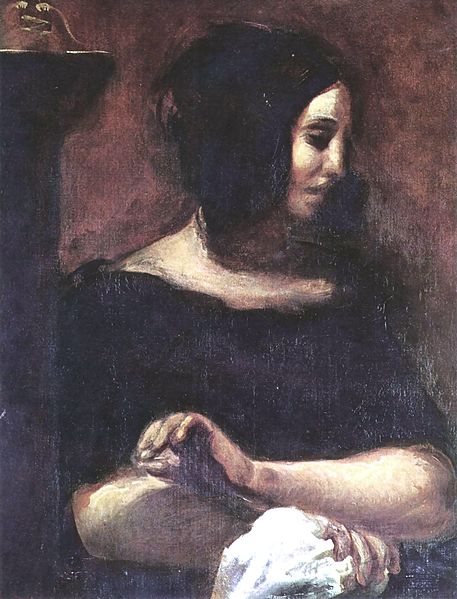Hi everybody!
Without our last message from Iain and Margaret, it would certainly have escaped us that today was the anniversary of the death of Frédéric Chopin, nor would we have known that this genial composer owed so much to a Scottish lady who, in the last and painful years of his short life, looked after him so devoted.
On a recent flight to Wroclaw, Poland, our friends met a charming Polish gentleman with whom they struck up a very interesting conversation. Iain writes :
I recall that we talked a bit – on the plane – about Chopin’s time in Scotland in the autumn of 1848. Monday – 17th October – is the Anniversary of Frederick Chopin’s death the following year.
Miss Jane Stirling – from a wealthy Scottish family, and who fancied that she was in love with Chopin – paid his funeral expenses. Chopin is buried in the Père Lachaise Cemetery, Paris – although his heart was taken home to Warsaw.
‘For where your treasure is, there will your heart be also.’ Under the stone lie a casket of Polish soil, a bunch of violets, and a rose petal from Scotland .. .. It has been said that Jane Stirling wore mourning clothes for the remainder of her life .. .. (Wikipedia!)
I do love Chopin’s music but I must confess that, except for his passionate relationships with George Sand, I don’t know much about his life.

Nohant George Sand's house in Berry, France © 2010 Scotiana
Last year, we visited Nohant, George Sand’s beautiful house in Berry, France. True enchantment! What a pity we could not take pictures inside the house where Chopin had spent so many happy days in company of George Sand and the many guests she used to invite there in a most cheerful atmosphere.
We stayed there up to the closing time… as if we were waiting for the echo of a few notes played on the old piano…

George Sand's grave in the family cemetery of Nohant © 2010 Scotiana
Before leaving this magical place, we visited the moving little family cemetery. There we stayed a long moment in silent contemplation at George Sand’s grave.
…………………………………..
As I was going to try and write a synthesis out of all the notes I had collected here and there on the web and more especially about Chopin’s relationships with Jane Stirling I received a message from Iain and Margaret who were offering me their help. How grateful I am to them. I could not have finished this post without their help.
Here’s Iain’s first message :
“I’ve managed to find the Zaluskis’ wee book The Scottish Autumn of Frederick Chopin .. .. on the back cover it says: “Chopin was already dying of tuberculosis when he came to Scotland in the early autumn of 1848 at the invitation of Jane Stirling of the renowned Scottish family. (Jane, a younger daughter, was plain Miss Stirling; Chopin had already, of course, been in London for some months.) Together they visited Calder House outside Edinburgh, Milliken House & Johnstone Castle near Glasgow, Strachur House on Loch Fyne, Gargunnock House in Stirlingshire, Keir House in Perthshire, and Hamilton Palace & Wishaw House in Strathclyde. Everywhere he was expected to play; he also gave a concert in both Glasgow & Edinburgh.
“This gruelling schedule proved too much, and was the cause of frequent return visits to the home of Dr Adam Lyscznski, a homoeopathic practitioner residing in Warriston Crescent, Edinburgh. In October (1848) a pale shadow of his former self, Chopin left for London, where he gave the last concert of his life before returning to Paris.”
” ‘Tomorrow I go back to Paris, hardly able to crawl, and weaker than ever,’ Chopin wrote to George Sand’s daughter, Solange, on 22 November, after his doctors had ordered him to leave (the polluted air of) London.”
For almost a year, Chopin lingered between life and death.

Last moments of Frédéric Chopin by Teofil Kwiatkowski, 1849-1850 - Frederic Chopin museum, Warsaw, Poland - Wikipedia
“Frederick Chopin died at 12 Place Vendôme, Paris, in the early hours of the morning on 17 October 1849. .. .. At his bedside were his sister Ludwika .. .. Princess Marcelina Czartoryska, Auguste Franchomme and Jane Stirling. And, of course, the faithful Daniel.*
” .. .. Jane Stirling (like George Sand, six years older than Chopin) wore black for the rest of her life – like a widow. Before her death on 6 February 1859 she worked tirelessly to collect, buy and send to Poland all of Chopin’s works, effects and furniture, including his piano, to form the nucleus of a collection for a Chopin museum. It was to be her last mistake .. .. In 1863, a gang of Russian Cossacks plundered the palace where they were preserved, and, deliberately selecting all the items from the Chopin museum, including his piano and the original Ary Scheffer portrait of Chopin, piled them up and made a bonfire of them, in a barbaric attempt to destroy Poland’s musical heritage .. .. .. ”
*Daniel: “His Italian servant had proved to be lazy and unreliable .. .. so Chopin sacked him on 1 July and in his place engaged an Irishman called Daniel. .. .. .. In Chopin’s eyes, Daniel was the equal of any gentleman. He was urbane and handsome, spoke fluent French, and showed considerable tact and diplomacy in dealing with Chopin’s changing moods. During the last 15 months of Chopin’s life, this loyal and devoted servant remained with him .. .. There is no record of either his surname, or of what became of him afterwards .. “
………………………………………………………………………………………………………………………………………………….
Bach is an astronomer, discovering the most marvellous stars.
Beethoven challenges the universe.
I only try to express the soul and the heart of man.
Frederic Chopin
Frédéric Chopin was born on March 1st (?) 1810 in the town of Zelazowa-Wola, near Warsaw, in Poland and died on October 17th 1849, in Paris, in the nice apartment situated 12 Place Vendôme, which he had bought some time before with the financial help of Jane Stirling. He was only twenty when he came to live in France but he would never forget his native country where he has always been worshipped as a national hero.
On the website of the Warsaw’s Chopin Museum I’ve found very interesting information about Jane Stirling.
Jane W. Stirling was Fryderyk Chopin’s student. She provided the composer with financial and emotional support during his final years. After Chopin’s death, she became an ambassador for preserving his art and life in remembrance. Jane W. Stirling purchased the majority of objects from Chopin’s last apartment. Shortly after Ludwika Jędrzejewiczowa had left Paris, she focused on putting the composer’s items in order and donated them to his close friends and relatives. As a result, Chopin’s personal items, letters, as well as objects of everyday use were sent to Warsaw. Delivery of the most valuable memorabilia, such as Chopin’s last Pleyel brand piano, was organized by Stirling with the utmost thoughtfulness.
Jane W. Stirling also cared deeply about preserving the composer’s artistic legacy. On her request, Ludwika Jędrzejewiczowa prepared a list of Unpublished Compositions remaining in the manuscripts. Living in Paris, Stirling engaged herself in initiatives undertaken after the composer’s death by his friends. In her correspondence with Ludwika Jędrzejewiczowa, she discussed the progress of works over Fryderyk Chopin’s tombstone at the Père Lachaise cemetery.
Jane W. Stirling treated Fryderyk Chopin’s personal items almost as relics. She wanted to protect them against destruction and rescue from oblivion. Yet, Stirling respected the value they held for his family in Warsaw. She did not hesitate to present Chopin memorabilia, which she owned, to his relatives: a death mask, miniature medallion with the composer’s image, or portraits of Fryderyk Chopin painted on her commission. Realizing the importance of the composer’s legacy, Stirling established a museum devoted to Fryderyk Chopin in Scotland. In her last will, she bequeathed part of the gathered collection to his family.
The five-year long correspondence between Jane W. Stirling and Ludwika Jędrzejewiczowa provides rich and detailed documentation of the history of Chopin’s legacy. It shows the amount of effort put after the composer’s death into preserving his memorabilia for the future generations.
http://chopin.museum/en/about/us
But then, a second message from Iain arrived: “Chers Amis, Margaret has kindly offered to type some more from that splendid wee book – she’s faster than me! :-)”
“Jane Wilhelmina Stirling was born at Kippenross House outside Dunblane on 15th July 1804. Jane was the youngest of 13 children, the adored and petted daughter of John Stirling, Laird of Kippendavie and Mary Graham.
John Stirling was a prominent member of the well-known middle-class Scottish family who had made a considerable fortune from trade with India. Pictures of ‘Jeanie’ in her youth show her to have been a very pretty girl, although her nose was considered too long for real beauty.
Her father died in 1816 when she was only 12; and when her mother died, four years later, she was taken in hand by her widowed elder sister, Katherine Erskine, who appears to have seen off any potential suitors for Jane, preferring to keep her as a constant companion in her widowhood.
In 1826 the now wealthy and inseparable sisters set off for Paris. In common with many other young ladies of means from Britain, a sojourn in the heady atmosphere of the French capital was de rigueur. They soon became fully involved in the Parisian experience and decided to stay on indefinitely.
In the autumn of 1840, they first met Chopin who had recently returned to Paris after his abortive trip to Majorca with George Sand. Within two years Jane had become Chopin’s piano pupil and her admiration for him grew and with it her devotion and affection. She became a very proficient pianist and Chopin once told her “One day you will play very, very well.” – a judgment not lightly bestowed. Her repertoire covered the greater part of Chopin’s output, even to the more difficult works, including the Concerto in F Minor, the Sonata in B Minor and the Fantasia in F Minor, all of which require a high degree of technical excellence. But one of her favourites was the less demanding Prelude in C Minor Op. 28 No. 20; she referred to this rich chorale-like Largo as La Prière. Chopin was very touched by her generosity of spirit, her kindness and her solicitousness, and in 1842 he dedicated his Nocturne In F Minor Op 55 No 1 to her, as well as the Nocturne in E Flat Op. 55 No 2 the following year.
In the spring of 1848, with Louis-Philippe gone and unrest in the air, Paris emptied of foreign patronage, and Jane and Katherine returned to their house in London. Jane begged Chopin to join the exodus, promising him success and fortune in the English capital.
With nothing whatsoever to lose, Chopin let out his Paris apartment, and followed her across the Channel to England. ”
Short as it was Frédéric Chopin’s life was rich and full of events and people but the autumn of his life is particularly moving. Here are the two ‘Nocturnes” written by Chopin for Jane Stirling and I can find no better way to pay homage to the Scottish lady as well as to the artist than to listen to them…
Chopin est au piano et ne s’aperçoit pas qu’on l’écoute. Il improvise comme au hasard. Il s’arrête.
– Eh bien ! Eh bien ! s’écrie Delacroix, ce n’est pas fini !
– Ce n’est pas commencé. Rien ne me vient… rien que des reflets, des ombres, des reliefs qui ne veulent pas se fixer. Je cherche la couleur ; je ne trouve même pas le dessin.
– Vous ne trouverez pas l’un sans l’autre, reprend Delacroix, et vous allez les trouver tous deux.
– Mais si je ne trouve que le clair de lune ?
– Vous aurez trouvé le reflet d’un reflet. »
(George Sand. Impressions et souvenirs. Source : A la table de George Sand Flammarion 1987)

Nohant George Sand's House in Berry France © 2010 Scotiana
Sa création était spontanée, miraculeuse. Il la trouvait sans la chercher, sans la prévoir. Elle venait sur son piano, soudaine, complète, sublime,
ou elle se chantait dans sa tête pendant une promenade, et il avait hâte de se la faire entendre à lui-même en la jetant sur l’instrument.
(George Sand)
To end this ‘In Memoriam’ page rather than the gloomy notes of the ‘Funeral March’ which could have sounded appropriate to such an event I’ve preferred the ‘Piano concerto no. 2 in F minor, Op. 21,’ where the violin adds its melancholy voice to the cheerful notes of the piano…
http://www.youtube.com/watch?v=l6C-paEymeo
I hope you’ll enjoy this moment.
A bientôt.
Mairiuna











An excellent piece, beautifully illustrated.
I am the Secretary & Administrator of the Chopin Society in London. You may be interested to check out our website where there are several articles on Chopin and his life.
We also have a Facebook page https://www.facebook.com/chopinsociety.org.uk
I bought one of my current pianos (a 6ft Grotrian Steinweg 1923) from the estate of a Dr McIntyre, 10 Warriston Crescent, Edinburgh not realising that this had been the home of Adam Lyszcsynski with whom Chopin stayed whilst in Edinburgh, and that he had been in that living room.I was interested in the address at the time as my mothers maiden name was also McIntyre. It was a fairly Spartan room at the front of the house, with kitchen and scullery behind.
[…] composed his popular Nocturne in E-flat major, Op. 9, No. 2 when he was about twenty. Like much of Chopin’s music, this nocturne is tinged with melancholy. Click on the arrow below to hear and listen to the […]
[…] composed his popular Nocturne in E-flat major, Op. 9, No. 2 when he was about twenty. Like much of Chopin’s music, this nocturne is tinged with melancholy. Click on the arrow below to hear and listen to the […]